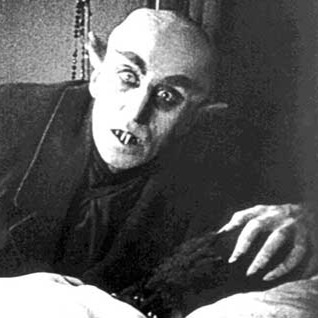Blood Types: Categorising Vampires
- Josie Jaffrey

- Nov 2, 2021
- 4 min read
I've been thinking about vampires recently (surprise, surprise). In particular, I've been thinking about the different kinds of vampire and how they manifest in fiction. (NB: scary vampire pictures follow, so look away now if you're squeamish!)
As I see it, vampires can easily be divided into two camps: (1) the powerful yet sexy ones and (2) the uncontrolled, animalistic ones. Since I started watching the old vampire films, I’ve begun to think of this as the Dracula/Nosferatu dichotomy. (If you’re unfamiliar with the films and want to see my thoughts on them, check out the #VenioVideoVampiro hashtag on Twitter.)
In the Dracula films (starting with Dracula in 1931), the titular count is handsome and seductive, luring his nightgown-clad victims into his arms with influence and affluence. However, in the Nosferatu films (starting with Nosferatu in 1922) there is no attempt to make the count alluring. Instead, he has rat-like teeth, bat-like ears and fingers elongated by extra joints. When he pounces on his victims he does so in a feral way, uncontrollably, and when he has finished feeding he lies across their bodies like a glutted pig. He feeds like a force of nature, not like a thinking being. These two depictions of essentially the same character stand firmly at opposite ends of the vampire spectrum.
And the Dracula/Nosferatu archetypes are persistent. They don't stop at Bela Lugosi and Max Schreck - they're still hanging around in modern vampire fiction. For the Nosferatu type (uncontrolled and animalistic) you have the piranha-toothed vampires of 30 Days of Night and the plague vampires of I Am Legend, almost more zombie than vampire. For the Dracula type (controlled and mesmerising) you have too many to list, but I'd put the vampires from films like Fright Night (both vintages) at the top of that list because of their single-minded focus on seducing people for their blood. Like the two-faced vampires of Buffy the Vampire Slayer, when their teeth come out, they change their faces from human to monster.

But there has been a definite shift since those archetypes were established. Most modern vampires push the Dracula end of the sliding scale a little further towards humanity, changing them from pure demons into bloodthirsty almost-humans with a soul (like Angel from Buffy the Vampire Slayer) or mostly decent people who try to get blood through honest means (like the vampires in True Blood and the Underworld films). They think and feel and love like humans. They're not all killers, though I'd argue they're more fun when they are.
Best of all are the vampires that are fine most of the time, but can go bad (for example, by drinking too much blood). I'm thinking of the strigoi in the Vampire Academy novels by Richelle Mead, or selected vampires from the Vampire Diaries TV show/novels. I confess that these are my favourite types of vampire. I love the pathos of Angel losing his soul in Buffy the Vampire Slayer, and the psychopathic episodes that follow as he wreaks his vengeance on the people he once loved. It's all about the agony when one part of a couple sees the other twisted and transformed. There's so much to unpack there, so many parallels you can draw between their actions and those of humans. Because that's what vampires are all about these days: we see ourselves reflected in them. We see them struggling with their desire, their addiction, and we see them turn feral when they lose control and give in to that weakness. We see them manipulate and seduce, and we wonder whether we would be drawn in too. Sometimes, we might even wish to succumb.

There's always been a seductive edge to Dracula, but modern stories imbue vampires with more. They're no longer a cautionary tale. Instead, they're appearing in our romance novels as the ultimate love interests, with all the emotional characteristics of humans but all the physical characteristics of superheroes, along with a little biting if you're kinky (Charlaine Harris, Kerrelyn Sparks, Lynsay Sands, the list goes on and on). In YA fiction, they're the ultimate sparkly boyfriends, and an allegory for abstinence (Stephenie Meyer's Twilight). They are the epitome of 'out of your league', making the human protagonists of those stories feel special simply to be chosen by them. There's also the thrill of being close to someone so dangerous and having to trust that they like you enough not to kill you. That kind of validation is seductive to many of our heroines.

And it is all too human. If, like me, you're fascinated not only by vampires but also by murder mysteries, it will not have escaped your notice that the two main categories of vampire have commonalities in the categorisation of serial killers. They are organised (like Dracula) or disorganised (like Nosferatu). The former are often psychopathic, and the Dracula-type vampires in fiction often do present as psychopaths. Perhaps these two categories of monster resonate with us for reasons that are grounded more in reality than in fantasy: we are familiar with the deliberate and psychopathic killer vs the unpredictable yet erratic one. We find both scary, or seductive (human nature being what it is, serial killers have their own fan clubs), but for very different reasons. Both have their place in vampire fiction, and in our nightmares.
This post originally appeared in my August 2021 newsletter.

-3.png)








Comments